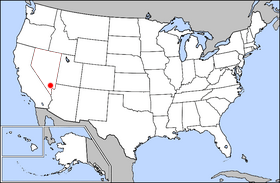Vegas Valley leopard frog facts for kids
Quick facts for kids Vegas Valley leopard frog |
|
|---|---|
| Conservation status | |
| Scientific classification | |
| Genus: |
Lithobates
|
| Species: |
fisheri
|
 |
|
| Former range (in red) | |
| Synonyms | |
|
Rana fisheri |
|
The Vegas Valley leopard frog (Lithobates fisheri) is a type of frog that was once thought to be extinct. This means people believed it had completely disappeared from Earth.
These frogs used to live in the Las Vegas Valley area. This includes places like Tule Springs in Clark County, southern Nevada, USA. They lived in areas that were between 370 and 760 meters (about 1,200 to 2,500 feet) above sea level. For a long time, it was believed to be the only frog native to the United States that had gone extinct in modern times.
Contents
What Happened to the Vegas Valley Leopard Frog?
On January 13, 1942, a person named A. Vanderhorst collected 10 of these frogs at Tule Springs. These frogs were thought to be the very last ones ever seen. Today, these special frogs are kept in the University of Michigan Museum of Comparative Zoology collection.
After many searches failed to find any more Vegas Valley leopard frogs, scientists sadly believed the species was extinct.
A Surprising Discovery
Something amazing happened in 2011! Scientists did a genetic analysis. This means they studied the DNA from the preserved museum frogs. They found something incredible: the DNA of the Vegas Valley leopard frog was exactly the same as a frog called the Chiricahua leopard frog (Lithobates chiricahuensis).
The Chiricahua leopard frog is still alive today, but it is threatened. This means it's not extinct, but its numbers are low and it needs protection.
Because the Vegas Valley leopard frog is genetically identical to the Chiricahua leopard frog, it is no longer considered extinct. Even though it disappeared from the Las Vegas area, the species itself still exists elsewhere.
Two Types of Leopard Frogs
Scientists now think there are two slightly different groups within these leopard frogs.
- One group is L. fisheri. This includes the old Vegas Valley leopard frogs and some Chiricahua leopard frogs from a place called the Mogollon Rim.
- The other group is L. chiricahuensis. This includes Chiricahua leopard frogs from southern and eastern parts of Arizona and New Mexico.
Scientists are still studying these frogs. They want to understand if there are even more types of leopard frogs, especially in northern Mexico. These frogs are also related to another unnamed leopard frog species found in Mexico.
Images for kids
See also
 In Spanish: Lithobates fisheri para niños
In Spanish: Lithobates fisheri para niños



